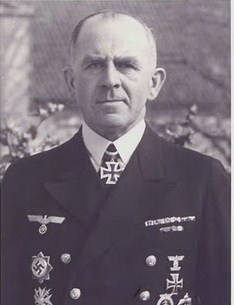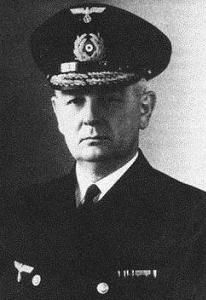Related Research Articles

The Reichsmarine was the name of the German Navy during the Weimar Republic and first two years of Nazi Germany. It was the naval branch of the Reichswehr, existing from 1919 to 1935. In 1935, it became known as the Kriegsmarine, a branch of the Wehrmacht; a change implemented by Adolf Hitler. Many of the administrative and organizational tenets of the Reichsmarine were then carried over into the organization of the Kriegsmarine.
Plan Z was the name given to the planned re-equipment and expansion of the Kriegsmarine ordered by Adolf Hitler in early 1939. The fleet was meant to challenge the naval power of the United Kingdom, and was to be completed by 1948. Development of the plan began in 1938, but it reflected the evolution of the strategic thinking of the Oberkommando der Marine over the two decades following World War I. The plan called for a fleet centered on ten battleships and four aircraft carriers which were intended to battle the Royal Navy. This force would be supplemented with numerous long-range cruisers that would attack British shipping. A relatively small force of U-boats was also stipulated.

Otto Ciliax was a German naval officer who served in the navies of the German Empire, the Weimar Republic and Nazi Germany. As an admiral during World War II, he commanded the German battleships. He was a recipient of the Knight's Cross of the Iron Cross.
The Seekriegsleitung or SKL was a higher command staff section of the Kaiserliche Marine and the Kriegsmarine of Germany during the World Wars.
Günther Hessler was a German naval officer during World War II. He commanded the Type IXB U-boat U-107, sinking twenty-one ships on three patrols, totalling 118,822 GRT of Allied shipping. Hessler was a recipient of the Knight's Cross of the Iron Cross and was commissioned after the war to write an account of the U-boat war by the British Ministry of Defence.

Otto Schniewind was a German General Admiral during World War II. He was a recipient of the Knight's Cross of the Iron Cross of Nazi Germany.

Rolf Hans Wilhelm Karl Carls was a high-ranking German admiral during World War II. He was a recipient of the Knight's Cross of the Iron Cross of Nazi Germany.

Hans-Jürgen Rudolf Reinicke was a German naval officer during World War II who commanded the German heavy cruiser Prinz Eugen.
Ernst Hechler was a German bomber pilot and U-boat commander in World War II. He was a recipient of the Knight's Cross of the Iron Cross of Nazi Germany. Hechler is credited with the sinking of four ships for a total of 13,804 gross register tons (GRT), and with damaging one destroyer escort.

Grille was an aviso built in Nazi Germany for the Kriegsmarine in the mid-1930s for use as a state yacht by Adolf Hitler and other leading individuals in the Nazi regime. The ship received a light armament of three 12.7-centimeter (5 in) guns and was fitted to be capable of serving as an auxiliary minelayer. Completed in 1935, her experimental high-pressure steam turbines, which were installed to test them before they were used in destroyers, required significant modifications and the ship finally entered service in 1937. Over the next two years, she was used in a variety of roles, including as a training vessel and a target ship, in addition to her duties as a yacht.

The organization of the Kriegsmarine refers to the operational and administrative structure of the German Navy from 1935 to 1945. Many of the organizational tenets of the Kriegsmarine were inherited from its predecessor the Reichsmarine. As World War II unfolded, the Kriegsmarine expanded to cover additional regions and responsibilities, most significant of which was the occupation of France and the Battle of the Atlantic.
The Fleet commander of the Kriegsmarine (Flottenchef) was the highest ranked administrative officer in the organization of the Kriegsmarine, and served as a member of the Oberkommando der Marine. The fleet commander did not actually serve as commander of an at-sea fleet, but instead was the senior officer to which the vessel type commanders reported. The position of fleet commander was created from an older position of the Reichsmarine known as Der Oberbefehlshaber der Seestreitkräfte.
Naval regions and districts were the official shore establishment of Nazi Germany's Kriegsmarine during World War II. The Kriegsmarine shore establishment was divided into four senior regional commands, who were in turn subordinated to the operational Navy Group commanders who commanded all sea and shore naval forces within a particular geographical region. Within each naval region were several subordinate naval districts who were responsible for all navy shore activities within their area of responsibility, most significantly were the various German ports of occupied Europe.
Flag officers of the Kriegsmarine were the leadership of the German Navy from 1935 to 1945. Most flag officers had also served as officers of the Reichsmarine, as well as the Imperial German Navy during World War I. German naval flag officers were divided into five Admiralty ranks while a senior captain rank, known as Kommodore also existed. The Kriegsmarine flag officers were responsible for holding the senior most naval positions within the organization of the Kriegsmarine.
The Marinestation der Ostsee was a command of both the Imperial German Navy, and the Reichsmarine which served as a shore command for German naval units operating primarily in the Baltic Sea. The station was headquartered at Kiel and was a counterpart command to the Marinestation der Nordsee.
During World War II, a sea defense zone (Seeverteidigung) was a tactical area in the organization of the Kriegsmarine intended to provide operational command of all German naval forces, within a given geographical area, in the event of actual enemy attack on the coastline of occupied Europe.

Leopold Siemens was a Vice admiral in the Kriegsmarine during World War II. He served as captain of the cruiser Karlsruhe in the mid 1930s and held the short lived position of Deputy fleet commander of the German Navy in 1941.
A type commander in the Kriegsmarine was a permanently assigned administrative officer in the organization of the Kriegsmarine which oversaw the development, deployment, and in some cases operational activities of the various classes of German naval vessels. Due to cross jurisdiction with the Navy group commanders, who tactically commanded all vessels at sea, some type commanders were little more than ceremonial officers who held a title with little authority. Others, such as Karl Dönitz who commanded the German U-boat force, exercised near total independence and held enormous authority, both operationally and administrative.
Fritz Krauss was a German naval officer, most recently a Konteradmiral in the World War II. Between 16 August 1944 – 22 July 1945, Fritz Krauss was Director of Department of Naval Intelligence, specifically 3 SKL/MND IV of the German Navy.
Hans Karl Meyer, was a German naval officer and Konteradmiral in the Kriegsmarine during World War II and most recently Flotilla admiral of the German Navy. Meyer was most notable for being commander of the battleship Tirpitz, of 1/Seekriegsleitung (SKL) Operations of Naval Command and being one of six Kriegsmarine admirals who were subordinated after World War II in the new German Navy.
References
- ↑ Hildebrand, hans. Die organisatorische Entwicklung der Marine nebst Stellenbesetzung 1848 bis 1945, Biblio-Verlag, Osnabrück (2000)
- ↑ Hildebrand H., Röhr A. & Steinmetz H. Die Deutschen Kriegsschiffe, Koehlers Verlagsgesellschaft. mbH, Hamburg (1980)
- ↑ Lohmann W. & Hildebrand H., Die Deutsche Kriegsmarine, Verlag Hans-Henning Podzun, Bad Nauheim (1956)